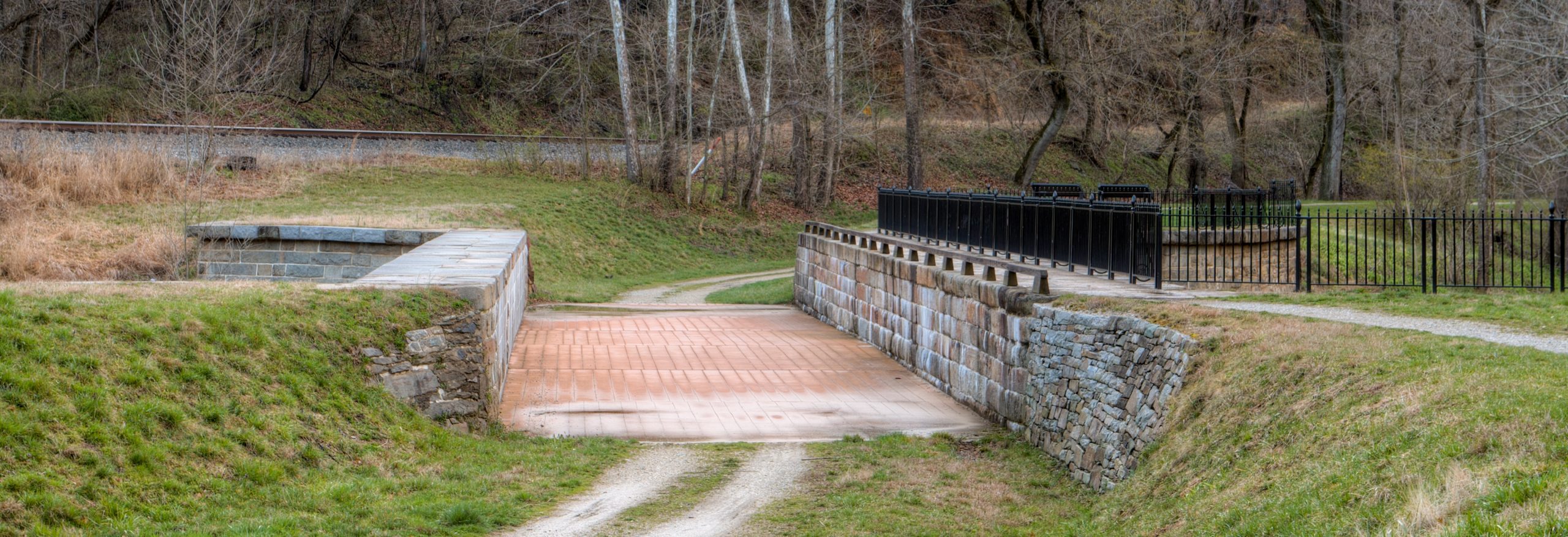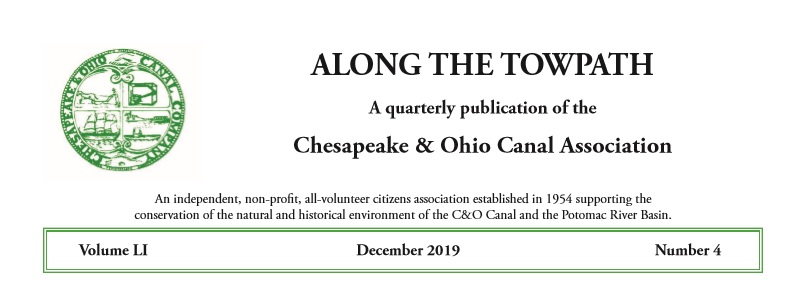Recent feature articles
- On The Importance of Large and Small Things, By Trent Carbaugh (March 2025 ATP)
- Building Blocks of the Canal: The Log Wall, By Stephanie Spencer (December 2024 ATP)
- How to Save Water and Fix a Broken Canal
Or
The Perils of Geology, By Trent Carbaugh (June 2024 ATP) - An Overview of Types of Bicycles to Ride the Towpath, By Trent Carbaugh (March 2024 ATP)
- Environmental Concerns of Railroads Along the C&O Canal and Potomac River, By Trent Carbaugh (September 2023 ATP)
- Trees, Fungus and Complexity Science, By Trent Carbaugh (June 2023 ATP)
- Tonoloway Creek Aqueduct and Environs, Mile 122.50 to 122.59, Hancock, Maryland, By Trent Carbaugh (March 2023 ATP)

Articles about the C&O Canal in the Civil War
 C&O Canal in the Civil War
C&O Canal in the Civil War
The articles listed below are from a continuing series in Along The Towpath. The publication dates are listed in parentheses.
A Balloon to Spy out the Land – Read about the modern experiment recreating Union Army balloon observations at Edwards Ferry. (June 2018)
Uncertain and Precarious: C&O Canal Navigation at the Beginning of the Civil War– Tim Snyder describes the difficulties of trying to do business on the border between the North and South in the first year of the war. (September 2017 & December 2017)
The C&O Canal in the Rockville Expedition by Tim Snyder – The first documented use of the C&O Canal to supply a Union command in the field occurred during the Rockville Expedition, which took place from June 10 to July 8, 1861. (June 2016)
The C&O Canal in Confederate Military History – Tim Snyder evaluates the importance of the C&O Canal to the Union during the American Civil War is by examining the effort the Confederate army invested in attempts to damage the waterway.(December 2015)
From War to Peace: The C&O Canal in 1865 and its Postwar Recovery – The year 1865 was one of transition for the canal. As the war ended, a host of problems confronted the canal company. The restoration following the war was an important factor in enabling the company to grow and to handle a heavy volume of goods in the decade that followed. By Tim Snyder. (June 2015)
The C&O Canal in 1864 – 150 Years Later – Tim Snyder writes about the ups and downs of the canal during the fourth year of the war. Confederates inflicted significant damage on the canal in a series of raids and invasions. By the end of the year, Union forces had turned the tide of battle, damage to the canal had been repairs, and the company’s fortunes looked brighter. (June 2014)
The Boatmen and the Civil War (Part 2) – Tim Snyder discusses the diverse pattern of nineteenth century boat ownership which included has come to light. Generally, at the time of the Civil War, four types of persons or entities owned boats that operated on the canal: 1) individuals, 2) transportation companies (forwarding merchants), 3) small business owners, and 4) large companies. (September 2013)
The Boatmen and the Civil War – Tim Snyder describes the perils of operating a boat on a canal that extended along the boundary between the North and South. Confederate raiders would burn canal boats. The Union Army seized boats to re-purpose them. Military campaigns caused boatmen to seek safe harbor, disrupting operations. (June 2013)
Josiah H. Gordon, President, Chesapeake & Ohio Canal Company – Gary Petrichick tells the story of Josiah Gordon, who was imprisoned as a Confederate sympathizer during the war, but later became president of the canal company. (March 2013)
Did Canal Boats Serve as Water Ambulances during the Civil War? – Tim Snyder discusses the problems which limited the use of canal boats to transport the sick and wounded. (December 2012)
The Battle of Shepherdstown Ford – Taking note of the 150th anniversary of the battle, Dave Johnson tells how the famous 20th Maine regiment gained their first combat experience along the canal. (September 2012)
The Canal, the War, and the Sterling Family – Dick Ebersole chronicles Confederate attempts to destroy Dam #5 in 1861. Ten-year-old Daniel Sterling witnessed the attack and later became a lockkeeper at the dam. (December 2011)
Divided Loyalties in Montgomery County and along the C&O Canal in the Civil War – Mike Dwyer uses a Provost Marshall’s report to illustrate the extent of Confederate sympathies in the area. (June 2011)
A Lockhouse Marriage: Private Franklin Swan of the 10th Vermont Infantry and Miss Mary Gaster – Grant Reynolds investigates the aftermath of a romance between a soldier and the relative of the Seneca Lock keeper. (June 2011 and September 2011)
C&O Canal and the US Civil War: Canalling on the Border between North and South – Tim Snyder describes the tensions along the canal in the early months of the war. (June 2011)
The War Moves North, by Gary M. Petrichick – In 1862, General Robert E. Lee’s first invasion of the north climaxed in the Battle of Antietam. This article recounts the campaign’s impact on the areas near the C&O Canal. (December 2010)
The War in Cumberland, by Gary M. Petrichick – Describes the events of the conflict in and around the city that is the western terminus of the C&O Canal. (September 2010)
Monocacy River Aqueduct, by Gary M. Petrichick – The aqueduct that carried canal boats over the Monocacy River was an important target for the Confederate forces. (June 2010)
C&O Canal and the Underground Railroad, by Timothy R. Snyder – Examines the role that the canal may have played in the escape of fugitives from slavery. (March 2010)
Blockhouses, by Gary M. Petrichick – Beginning in 1861, miniature fortresses guarded strategic points along the canal and the Potomac River. (December 2009)
Case of Lockjaw, by Dave Johnson. – Union plans to use canal boats as supports for a bridge at Harpers Ferry were frustrated in 1862 when a river lock proved too narrow. (September 2009, reprinted from June 2000)
Ferry Hill Place, by Gary M. Petrichick – The mansion across the Potomac River from Shepherdstown, W.Va., figured in several incidents during the war, in which the son of the property’s owner fought for the Confederacy. (June 2009)
Arrest!, by Gary M. Petrichick – The Chesapeake and Ohio Canal Company’s president was more than once detained by federal authorities during the war. (March 2009)
Gettysburg Crossings, by Gary M. Petrichick – In 1863, Confederate forces crossed and damaged the canal at several points on their way to and from the crucial battle at Gettysburg. (December 2008)
Battles at Folcks Mill and Oldtown, by Gary M. Petrichick – In 1864, Confederate forces advancing on Cumberland were foiled at Folcks Mill, but then overcame Union troops who tried to block their retreat at Oldtown. (September 2008)
The Dams, by Gary M. Petrichick – The dams used to divert Potomac River water into the canal were a frequent target of Confederate forces. (June 2008)
Battle of Balls Bluff, by Gary M. Petrichick – In October 1861, Union troops who crossed to Virginia suffered a significant defeat a few miles downriver from Edwards Ferry. (March 2008)
Five Vermont Solders Spend a Quiet Year on the Canal, by Grant Reynolds. – During 1862-63, recruits from a small New England town helped to guard the area of Poolesville, Md. (December 2007)
Battle of Shepherdstown (Boteler’s Ford) – adapted from Shepherdstown Battlefield Preservation Association publications. This 1862 engagement involved one of the most significant canal/river crossings of the Civil War. (September 2007)
A Brief Overview, by Gary M. Petrichick – An introduction to the role of the C&O Canal in the Civil War, with reflections on history. (June 2007)
Wildflower and plant guides
Photo Guide to Spring Wildflowers on the Towpath (A 25-page PDF document compiled during the 2009 Douglas Hike)
Wildflower Guide (A two-page text document, listing wildflowers found along the towpath from Swain’s Lock to Carderock, describing where and when they bloom)
Plants in the Park guide, a 14-page document published by Chesapeake and Ohio Canal National Historical Park. (Word version)
DC Area Plants Guide – This 17-page guide includes a sample of the various species of flowers, trees, and shrubs throughout DC. The park created the guide collaboration with Georgetown Heritage. (Word version)

